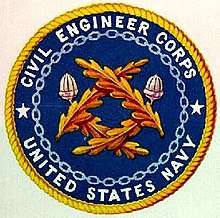Civil Engineer Corps
The Civil Engineer Corps (CEC) is a staff corps of the United States Navy. CEC officers are professional engineers and architects, acquisitions specialists and Seabee Combat Warfare Officers. They are responsible for executing and managing the planning, design, acquisition, construction, operation, and maintenance of the Navy's shore facilities. The Civil Engineer Corps is under the command of the Chief of Civil Engineers and Commander, Naval Facilities Engineering Command. As of 19 October 2018, RADM John W. Korka relieved RADM Bret J. Muilenburg, and became the 45th commander of NAVFAC and Chief of Civil Engineers.[1]
CEC ranks range from CWO2 to RADM, though the community is phasing out Chief Warrant Officer ranks in favor of Limited Duty Officers. As of August 2018, the CEC Active-Component end-strength was 1,285 personnel composed of 1 RADM, 3 RDML's, 76 CAPT's, 166 CDR's, 278 LCDR's, 470 LT's, 171 LTJG's, and 120 ENS's, distributed worldwide. As of August 2018, the CEC Reserve-Component end-strength was 448 personnel, composed of 2 RDML's, 29 CAPT's, 80 CDR's, 142 LCDR's, 156 LT's, 9 LTJG's, and 25 ENS's, distributed worldwide. Several Civil Engineer Corps officers, primarily those serving during or around the time of World War 2, have held the rank of Vice Admiral, and one officer has held the 4 star rank of Admiral, but there are no current billets within the US Navy that require Civil Engineer Corps officers of either rank.
History
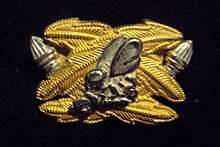
Civil engineers were employed by the Navy Department as early as 1827, when Mr. Loammi Baldwin was appointed to superintendent of the construction of dry docks at Boston and Norfolk.[2] Prior to the passage of the Act of 2 March 1867 civil engineers were appointed by the Secretary, but under authority of that act they were to be commissioned by the President by and with the advice and consent of the Senate; they were appropriated for as part of the civil establishment at the several navy yards and stations under the control of the Bureau of Yards and Docks until 1870.[2] At that time their pay was regulated by section 3 of the Act of 15 July 1870 that "fixed" the annual pay of officers of the Navy on the active list.[2] Appropriations for their pay have been made since 1870 under the head of "Pay of the Navy".
The discretionary authority given to the President by the Statute of 3 March 1871, to determine and fix the relative rank of civil engineers was not exercised until the 24th of February 1881, when relative rank was conferred upon them and fixed as follows: One with the relative rank of captain (CAPT), two with that of commander (CDR), three with that of lieutenant-commander (LCDR), and four with that of lieutenant (LT).[2]
The Navy Regulations for 1876 failed to list civil engineers among the staff officers of the Navy, and the uniform regulations for that year did not prescribe a uniform or a corps device for that class of officer. In 1881, after having had relative rank conferred upon them, civil engineers were instructed by Uniform Circular dated 24 August to wear the uniform of officers of the line with whom they had relative rank - omitting the star, but with the distinctive letters C.E. (Old English) embroidered in silver in the center. The same letters to be similarly embroidered on frogs of epaulets.
In 1905, two crossed silver sprigs, each composed of two oak leaves and an acorn (sometimes called "Crossed Bananas"), was adopted as the insignia of the Civil Engineer Corps replacing the Old English letters C.E. These were to be worn on the epaulets, shoulder straps and collar of the service coat.[2] While the pattern of this corps device remained the same, uniform regulations issued in 1919 specified that it was to be embroidered in gold instead of silver and worn on the sleeve of frock, evening dress, and blue service coats, above the gold lace strips, and on shoulder marks for white service coat and overcoat. By these same regulations the light blue cloth worn under the sleeve strips, and worn on the shoulder marks since 1899, was abolished as a distinction of the corps, however is still present in the light blue color of the stripes worn by enlisted, pay grades E-3 and below in the Navy's construction field.
In 1939 the CEC was composed of 126 active officers. By VJ day that number had grown to only 200. However, there were over 10,000 reservists providing the leadership of the Construction Battalions.[2] In December 1941 Admiral Ben Moreell proposed the creation of 3 Naval Construction Battalions. A problem then confronted BuDocks, who would command the Construction Battalions? Naval regulations stated that military command of naval personnel was strictly limited to line officers, yet BuDocks deemed it essential that these Construction Battalions be commanded by officers of the Civil Engineer Corp, who were trained in the skills required for construction work. The newly formed Bureau of Naval Personnel (BuPers), successor to the Navy's Bureau of Navigation, strongly opposed this transgression of Naval tradition. Admiral Moreell took the question personally to the Secretary of the Navy, Frank Knox, who, on 19 March 1942, gave authority for officers of the Civil Engineer Corps to exercise military authority over all officers and enlisted men assigned to construction units otherwise known as the Seabees. For those engineers assigned to the Seabees a silver Seabee was mounted to the center of the CEC crossed oak leaves insignia. The Seabee logo incorporated the CEC insignia, with one on each arm of the Seabee, just above each glove.
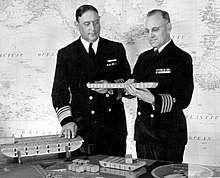
Besides providing the command leadership and engineering skills needed by the Naval Construction Force(NCF), the CEC made a major contribution to the war effort. CAPT. John N. Laycock created the Seabee's "magic box".[3] Today's Navy lighterage pontoon is a direct descendent of his creation.
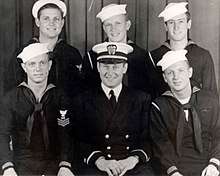
The first CEC killed in Pacific combat were Lt. Irwin W. Lee and Lt. (jg) George W. Stephenson along with 23 enlisted of the 24th CB. They died in an air raid on 2 July 1943 on Rendova Island. The Seabees named their Naval Training Center at Quoddy Village Eastport, Maine, Camp Lee-Stephenson in honor of them.[5] The first CEC killed in the Atlantic combat was Lt. Carl M. Olson of St Paul, Minnesota. That happened on 10 September 1943 at Salerno, Italy. His design for the landing end of pontoon assemblies was used throughout the war.[6]
- Capt. Wilfred L. Painter (CEC) awarded four Gold Stars for the Legion of Merit with Combat "V"[7]
USMC
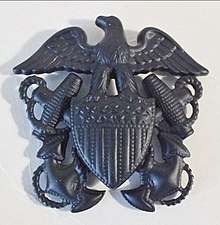
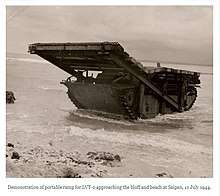
During WWII the Seabees had a number of battalions transferred to the Marine Corps.[8][9][10] Those battalions were then given USMC designations and the men were given standard Marine Corps issue in addition to their dress naval uniform. For CEC the standard gold and silver officer corps insignia was replaced by a brass subdued one on the garrison hat. The battalions involved were the 18th, 19th, 25th, 53rd and 121st.(see 17th Marine Regiment, 18th Marine Regiment, 19th Marine Regiment, and 20th Marine Regiment) The 31st and 133rd CBs were issued USMC fatigues and attached to the shore parties of the 4th Marine Division and 5th Marine Division for Iwo Jima. The CEC involved would have worn the subdued insignia also. Other battalions were tasked with Marine Corps shore party assignments both prior and post Iwo Jima.
Tasked as combat engineers, the CEC of the 18th and 121st CBs designed a detachable ramp mounted on a LVT-2.[11] Its purpose was to enable the Marines to land on Tinian's beaches bordered by coral embankments up to 15 feet high. Ten LVTs were modified using iron beams salvaged from a sugar factory on Saipan.[11] The commanding General Harry Schmidt was skeptical of the design. He ordered that a vehicle test one, a hundred times, before he would use it in combat. The ramps not only stood up, but they allowed the Marines to land where there were no defenses as a landing there had been thought impossible.[11] The astonished Japanese were overwhelmed and outflanked due to the ramps. The LVTs were nicknamed "doodlebugs".
USMC Shore party Commanders
- Guam: 3rd Marine Regiment, Cmdr. Wehlen CEC 3rd Battalion 19th Marines / Naval Construction Battalion 25 beaches Red 1 and Red 2
- Bougainville: 3rd Marine Division Cmdr. Brockenbrough CEC 71st CB with detachments from the 25th, 53rd, and the 75th CBs (and as well as the Marines).[12] beaches: Blue 1,2,3 Yellow 1,2,3,4 Green 1,2 Red 1,2,3
- Iwo Jima: 23rd Marine Regiment Cmdr. Raymond P. Murphy CEC, 133rd CB beaches Yellow 1 and Yellow 2.
Naval Combat Demolition Units
Operational Naval Demolition Unit No. 1. was the very first USN "demolitions" unit. In early May 1943, a two-phase "Naval Demolition Project" was directed by the Chief of Naval Operations "to meet a present and urgent requirement". The first phase began at Amphibious Training Base (ATB) Solomons, Maryland with the establishment of Operational Naval Demolition Unit No. 1. Six Officers and eighteen enlisted men reported from NTC Camp Peary dynamiting and demolition school, for a four-week course. Those Seabees, lead by Lieutenant Fred Wise CEC, were immediately sent to participate in the invasion of Sicily.[13] When the unit returned to Camp Peary most of the men were assigned to the new Naval Combat Demolition Units being formed there.
Naval Combat Demolition Units were led by junior CEC officers.[15] There were over 200 NCDUs formed with all but five being reqresitioned for the UDTs.
UDTs
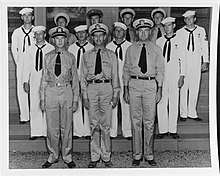
V Amphibious Corps had identified coral as an issue for Amphibious landings in the Pacific and determined Naval Constructions Battalions had the only people with any experience with the material. Lt. Thomas C. Crist CEC, from NCB 10 was in Honolulu from Canton Island where he had been involved in a lagoon coral head clearance project.[16] His being in Pearl Harbor turned out to be pivotal in UDT history. He heard that Admiral Turner was interested in blasting coral and made contact. The Admiral commissioned Lt. Crist with developing a method to blast coral under combat conditions and staging qualified men in Pearl to form a unit for that task. Lt. Crist had staged 30 officers and 150 enlisted when the disaster at Tarawa happened. With Kwajalein the next operation Lt. Crist's 180 men were used to form UDT 1 and UDT 2. Cmdr. E.D. Brewster (CEC) was selected to command UDT 1 and Lt Crist was picked for UDT 2. That did not last as Admiral Connelly wanted a commander with combat experience. So, Lt. Crist was made ops officer for team 2. Upon returning to Hawaii Lt. Crist was named as the first Training Officer of the UDT program. He was in the position only a short time when he was selected as commander of UDT 3. For the Marianas operations of Kwajelein, Roi-Namur, Siapan, Tinian, Eniwetok, and Guam. Admiral Turner recommended sixty silver stars and over three hundred bronze stars with Vs for the Seabees and others of UDTs 1-7[17] That was unpresendented in U.S. Naval/Marine Corps history.[17] For UDTs 5 and 7 every officer received a silver star and all the enlisted received bronze stars with Vs for Operation Forager (Tinian).[13] For UDTs 3 and 4 every officer received a silver star and all the enlisted received bronze stars with Vs for Operation Forager (Guam).[13] Admiral Richard Lansing Conolly felt the commanders of teams 3 and 4 (Lt. Crist and Lt. W.G. Carberry) should have received Navy Crosses.[13] When UDT 3 returned from Leyte in November 1944 it became the training instructors of the Maui school and Lt. Crist was made base Training Officer again .[18] The team would remain in these jobs until April 1945 when it was sent to Fort Priece to do the same job there. Lt. Crist had been promoted to Lt. Cmdr. and was sent back to Hawaii but his Team 3 Seabees would train teams 12–22.[18]
Diving masks were not common in 1944 and a few men had tried using goggles at Kwajalein.[19] They were a rare item in the Hawaiian sports stores so Lt. Crist and Seebee Chief Howard Roeder and put in a request to supply for them.[19] A fortuitous observation spotted a diving mask ad in a magazine. That prompted a priority dispatch to the States appropriating the store's entire stock.[19]
Prisoners of War
During WWII fifteen CEC were taken pow.[20] All were in the Pacific and all were taken at the onset of hostilities at Cavite, Philippines, Wake, and Guam.[20] Six would die: 1 executed, 2 friendly fire, 3 mal-treatment.[20] One pow, Lt. Jerry Steward, received the Navy Cross, Purple heart with 3 gold stars, Army Distinguished Unit Badge with Oak leaf cluster, Philippine Distinguished Service Star and was the most decorated CEC officer of WWII.[21] Postwar he would eventually retire as a Rear Admiral.[20]
Camp David
The presidential retreat is officially Naval Support Facility Thurmont. The CEC staffs the base command. The Marine Corps provides base security while Seabees oversee base operations and maintenance. The current base commander is Cmdr. Jeremy Ramburg(CEC) while the executive officer is Lcdr. Jannira Gregory (CEC).[22]
- The Naval Special Warfare Command building at the U.S.N. Seal base at Fort Pierce is named for LTJG Frank Kaine CEC commander of NCDU 2.
- In March 2014, RADM Katherine L. Gregory, CEC, USN became the first woman to lead the CEC.[23]
| No. | Start | End | Rank In Office | Chief Of Civil Engineers | Command |
|---|---|---|---|---|---|
| 1 | 1842 | 1846 | CAPT | Lewis Warrington | Bureau of Yards and Docks |
| 2 | 1846 | 1849 | CAPT | Joseph Smith | Bureau of Yards and Docks |
| 3 | 1869 | 1871 | CAPT | Daniel Ammen | Bureau of Yards and Docks |
| 4 | 1871 | 1874 | CDRE | Christopher R. P. Rodgers | Bureau of Yards and Docks |
| 5 | 1874 | 1878 | CDRE | John C. Howell | Bureau of Yards and Docks |
| 6 | 1878 | 1881 | CDRE | Richard L. Law | Bureau of Yards and Docks |
| 7 | 1881 | 1885 | CDRE | Edward T. Nichols | Bureau of Yards and Docks |
| 8 | 1885 | 1889 | CDRE | David B. Harmony | Bureau of Yards and Docks |
| 9 | 1889 | 1890 | CDRE | George D. White | Bureau of Yards and Docks |
| 10 | 1890 | 1894 | CDRE | Norman H. Farquhar | Bureau of Yards and Docks |
| 11 | 1894 | 1898 | CDRE | Edmund O. Matthew | Bureau of Yards and Docks |
| 12 | April 1898 | January 1907 | RADM | Mordecai T. Endicott | Bureau of Yards and Docks |
| 13 | January 1907 | March 1907 | RADM | Harry H. Rousseau | Bureau of Yards and Docks |
| 14 | March 1907 | January 1912 | RADM | Richard C. Hollyday | Bureau of Yards and Docks |
| 15 | January 1912 | January 1916 | RADM | Homer R. Stanford | Bureau of Yards and Docks |
| 16 | January 1916 | November 1917 | RADM | Frederic R. Harris | Bureau of Yards and Docks |
| 17 | January 1918 | December 1921 | RADM | Charles W. Parks | Bureau of Yards and Docks |
| 18 | December 1921 | December 1929 | RADM | Luther E. Gregory | Bureau of Yards and Docks |
| 19 | December 1929 | December 1933 | RADM | Archibald L. Parsons | Bureau of Yards and Docks |
| 20 | December 1933 | November 1937 | RADM | Norman M. Smith | Bureau of Yards and Docks |
| 21 | December 1937 | December 1945 | RADM | Ben Moreell | Bureau of Yards and Docks |
| 22 | December 1945 | December 1949 | RADM | John J. Manning | Bureau of Yards and Docks |
| 23 | December 1949 | November 1953 | RADM | Joseph F. Jelly | Bureau of Yards and Docks |
| 24 | November 1953 | September 1955 | RADM | John R. Perry | Bureau of Yards and Docks |
| 25 | November 1955 | November 1957 | RADM | Robert H. Meade | Bureau of Yards and Docks |
| 26 | December 1957 | February 1962 | RADM | Eugene J. Peltier | Bureau of Yards and Docks |
| 27 | February 1962 | October 1965 | RADM | Peter Corradi | Bureau of Yards and Docks |
| 28 | November 1965 | August 1969 | RADM | Alexander C. Husband | Naval Facilities Engineering Command |
| 29 | August 1969 | May 1973 | RADM | Walter M. Enger | Naval Facilities Engineering Command |
| 30 | May 1973 | May 1977 | RADM | Albert R. Marschall | Naval Facilities Engineering Command |
| 31 | May 1977 | January 1981 | RADM | Donald G. Iselin | Naval Facilities Engineering Command |
| 32 | January 1981 | August 1984 | RADM | William M. Zobel | Naval Facilities Engineering Command |
| 33 | August 1984 | August 1987 | RADM | John Paul Jones, Jr. | Naval Facilities Engineering Command |
| 34 | August 1987 | October 1989 | RADM | Benjamin F. Montoya | Naval Facilities Engineering Command |
| 35 | October 1989 | September 1992 | RADM | David E. Bottorff | Naval Facilities Engineering Command |
| 36 | 18 September 1992 | 14 September 1995 | RADM | Jack E. Buffington | Naval Facilities Engineering Command |
| 37 | 15 September 1995 | 24 September 1998 | RADM | David J. Nash | Naval Facilities Engineering Command |
| 38 | 25 September 1998 | 19 October 2000 | RADM | Louis M. Smith | Naval Facilities Engineering Command |
| 39 | 20 October 2000 | 23 October 2003 | RADM | Michael R. Johnson | Naval Facilities Engineering Command |
| 40 | 24 October 2003 | 26 October 2006 | RADM | Michael K. Loose | Naval Facilities Engineering Command |
| 41 | 27 October 2006 | 20 May 2010 | RADM | Wayne "Greg" Shear | Naval Facilities Engineering Command |
| 42 | 21 May 2010 | 25 October 2012 | RADM | Christopher J. Mossey | Naval Facilities Engineering Command |
| 43 | 26 October 2012 | 3 November 2015 | RADM | Katherine L. Gregory | Naval Facilities Engineering Command |
| 44 | 4 November 2015 | 18 October 2018 | RADM | Bret J. Muilenburg | Naval Facilities Engineering Command |
| 45 | 19 October 2018 | Present | RADM | John W. Korka | Naval Facilities Engineering Command |
See also
References
- Affairs, This story was written by Don Rochon, Naval Facilities Engineering Command Public. "NAVFAC, Civil Engineer Corps holds Change of Command". www.navy.mil. Retrieved 2016-01-21.
- History of the CEC, p. 18
- The Navy's Pinup Boxes, Popular Science, Commodore W. Mack Angas CEC, Feb. 1946 "Navy's pin-up Boxes", February 1946, Popular Science illustrations of NPL units
- Blazich, Frank A. (6 June 2014). "Opening Omaha Beach: Ensign Karnowski and NCDU-45". Seabees Online. Navy Facilities Engineering Command. Retrieved 18 October 2017.
- CAMP LEE-STEPHENSON MONUMENT AT QUODDY VILLAGE, EASTPORT, MAINE, CEC / Seabee Historical Foundation PO Box 657, Gulfport, MS 39502, (228) 865-0480, info@seabeehf.org
- The King Bee. Capt. A.N. Olsen (CEC), Trafford Publishing, 2007
- Wilfred L. Painter, NHHC website, Seabee Museum Archive, Port Hueneme, CA, Jan. 31, 2020
- Huie, William Bradford (1945). Can Do!: The Story of the Seabees. New York: E. P. Dutton.
- "WWII CB uniform". Weebly.com. Retrieved 18 October 2017.
- "WWII CB uniform, 1944 Leatherneck Magazine". weebly.com. Retrieved 18 October 2017.
- Seabees and doodlebugs at Tinian, This date in Seabee History July 24, 1944, Seabee Museum website, Port Hueneme, CA[V]
- 71st U.S. Naval Construction Battalion. U.S. Navy Seabee Museum. p. 14.
- Naked Warriors, Cdt. Francis Douglas Fane USNR (Ret.), St. Martin's Press, 175 Fifth Ave, New York, NY 10010, 1996, pp. 122, 131, ISBN 0-312-95985-0
- Seabee online magazine- this week in Seabee History
- Lt Crist, "The MOCK-UP", Fort Pierce Amphibious Training Base (ATB) Newspaper, 20 July 1945 , p. 4, Fort Pierce SEAL Archives, Fort Pierce, FL.
- "America's First Frogman", Elizabeth K. Bush, Naval Institute Press, 291 Wood Road, Annapolis, Maryland, 2012, Chapt. 7, ISBN 978-1-61251-298-3
- "The Teams in World War II". View of the Rockies. Retrieved 18 October 2017.
- Naked Warriors, Cdr. Francis Douglas Fane USNR (Ret.), St. Martin's Press, 175 Fifth Ave, New York, NY 10010, 1996, p. 82, ISBN 0-312-95985-0
- CEC WWII prisoners of war, Civil Engineering Corps History, Naval History Heritage Command, Seabee Museum Archives,Port Hueneme,CA
- Rear Admiral Jerry Stewart, Find a Grave, database and images memorial page for Adm Jerry Alexander Steward (26 Jan 1895–20 Sep 1960), Find a Grave Memorial no. 13098273, citing Stewards Mill Cemetery, Stewards Mill, Freestone County, Texas, USA.
- Biographies, CNIC, Naval Support Facility Thurmont web page, Commander, Navy Installations Command, 716 Sicard Street SE, Suite 1000 Washington, DC 20374-5140
- "Gregory Named to Lead NAVFAC, First Woman to Hold the Post". June 18, 2012. Retrieved 2012-06-20.
